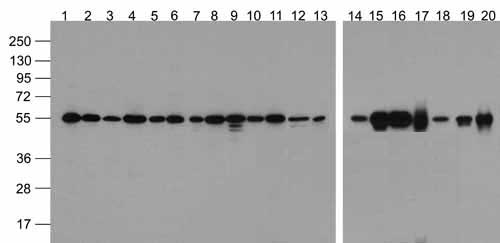Alpha-tubulin Antibody (biotin)
- SPECIFICATION
- CITATIONS
- PROTOCOLS
- BACKGROUND

Application
| WB, E |
|---|---|
| Primary Accession | Q71U36 |
| Other Accession | 37492, CAA25855, 7846 |
| Reactivity | Human, Mouse, Rat, Rabbit, Zebrafish, Chicken |
| Host | Rabbit |
| Clonality | Polyclonal |
| Isotype | IgG |
| Calculated MW | 50136 Da |
| Application Notes | Biotin-Alpha-tubulin antibody can be used for detection of alpha-tubulin by Western blot at 1 - 2 µg/ml. |
| Gene ID | 7846 |
|---|---|
| Other Names | Tubulin alpha-1A, TUBA1A, TUBA3, LIS3 |
| Precautions | Alpha-tubulin Antibody (biotin) is for research use only and not for use in diagnostic or therapeutic procedures. |
| Name | TUBA1A |
|---|---|
| Synonyms | TUBA3 |
| Function | Tubulin is the major constituent of microtubules, a cylinder consisting of laterally associated linear protofilaments composed of alpha- and beta-tubulin heterodimers. Microtubules grow by the addition of GTP-tubulin dimers to the microtubule end, where a stabilizing cap forms. Below the cap, tubulin dimers are in GDP-bound state, owing to GTPase activity of alpha-tubulin. |
| Cellular Location | Cytoplasm, cytoskeleton. Cytoplasm, cytoskeleton, flagellum axoneme {ECO:0000250|UniProtKB:P68369} |
| Tissue Location | Expressed at a high level in fetal brain. |

Thousands of laboratories across the world have published research that depended on the performance of antibodies from Abcepta to advance their research. Check out links to articles that cite our products in major peer-reviewed journals, organized by research category.
info@abcepta.com, and receive a free "I Love Antibodies" mug.
Provided below are standard protocols that you may find useful for product applications.
Background
Alpha-tubulin belongs to the tubulin superfamily, which is composed of six distinct families. Along with beta-tubulins, alpha-tubulins are the major components of microtubules. These microtubules are involved in a wide variety of cellular activities ranging from mitosis and transport events to cell movement and the maintenance of cell shape. Alpha- and beta-tubulin dimers are assembled to 13 protofilaments that form a microtubule of 22-nm diameter (reviewed in 1). Tyrosine ligase adds a C-terminal tyrosine to monomeric alpha-tubulin. Assembled microtubules can again be detyrosinated by a cytoskeleton-associated carboxypeptidase (2). Another post-translational modification of detyrosinated alpha-tubulin is C-terminal polyglutamylation, which is characteristic of microtubules in neuronal cells and the mitotic spindle (3). Like GAPDH and -Actin, this antibody makes an excellent loading control in immunoblots.
References
McKean PG, Vaughan S, and Gull K. The extended tubulin family. J. Cell Sci. 2001; 114:2723-33.;Barra HA, Arce CA, and Argarana CE. Posttranslational tyrosination/detyrosination of tubulin. Mol. Neurobiol. 1988; 2:133-53.;Fukshima N, Furuta D, Hidaka Y, et al. Post-translational modifcations of tubulin in the nervous system. J. Neurochem. 2009; 109:683-693.;
If you have used an Abcepta product and would like to share how it has performed, please click on the "Submit Review" button and provide the requested information. Our staff will examine and post your review and contact you if needed.
If you have any additional inquiries please email technical services at tech@abcepta.com.













 Foundational characteristics of cancer include proliferation, angiogenesis, migration, evasion of apoptosis, and cellular immortality. Find key markers for these cellular processes and antibodies to detect them.
Foundational characteristics of cancer include proliferation, angiogenesis, migration, evasion of apoptosis, and cellular immortality. Find key markers for these cellular processes and antibodies to detect them. The SUMOplot™ Analysis Program predicts and scores sumoylation sites in your protein. SUMOylation is a post-translational modification involved in various cellular processes, such as nuclear-cytosolic transport, transcriptional regulation, apoptosis, protein stability, response to stress, and progression through the cell cycle.
The SUMOplot™ Analysis Program predicts and scores sumoylation sites in your protein. SUMOylation is a post-translational modification involved in various cellular processes, such as nuclear-cytosolic transport, transcriptional regulation, apoptosis, protein stability, response to stress, and progression through the cell cycle. The Autophagy Receptor Motif Plotter predicts and scores autophagy receptor binding sites in your protein. Identifying proteins connected to this pathway is critical to understanding the role of autophagy in physiological as well as pathological processes such as development, differentiation, neurodegenerative diseases, stress, infection, and cancer.
The Autophagy Receptor Motif Plotter predicts and scores autophagy receptor binding sites in your protein. Identifying proteins connected to this pathway is critical to understanding the role of autophagy in physiological as well as pathological processes such as development, differentiation, neurodegenerative diseases, stress, infection, and cancer.


